Items
Subject is exactly
Architecture & Planning
-
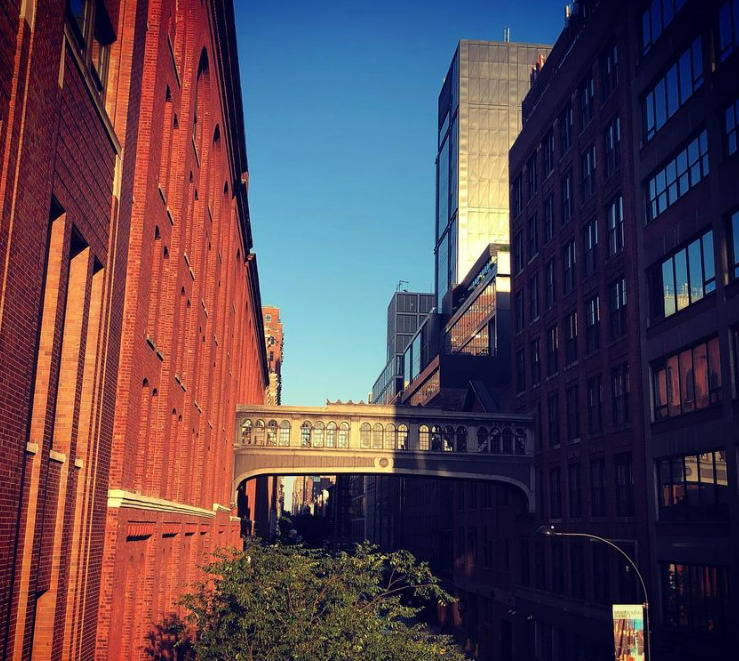 July 21, 2020
July 21, 2020#highline #nyc #goldenhour #bridgeofsighs #bluesky
#highline #nyc #goldenhour #bridgeofsighs #bluesky https://instagr.am/p/CC7EWhrpc-j/ -
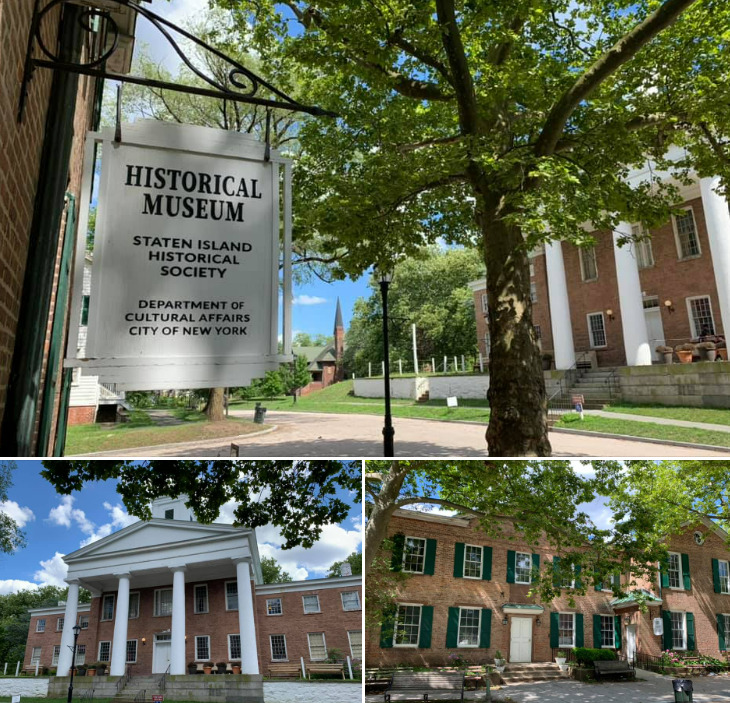 July 22, 2020
July 22, 2020A nice walk through Historic Richmond town.
A nice walk through Historic Richmond town. -
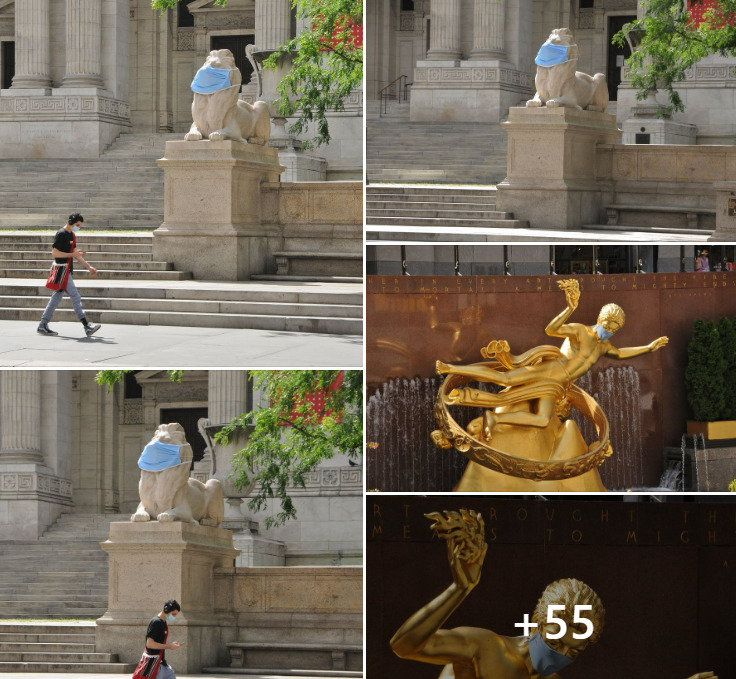 July 27, 2020
July 27, 2020A Covid Summer in NYC
A Covid Summer in NYC -
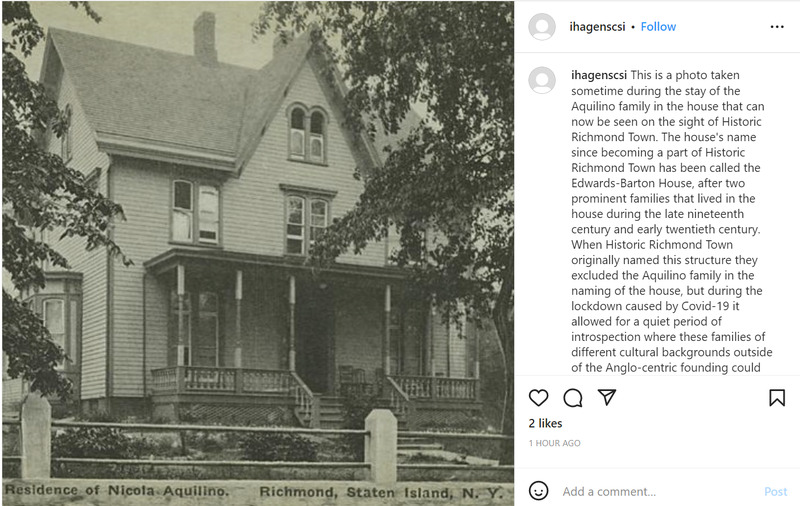 2023-02-28
2023-02-28Aquilino House
This is a photo taken sometime during the stay of the Aquilino family in the house that can now be seen on the sight of Historic Richmond Town. The house's name since becoming a part of Historic Richmond Town has been called the Edwards-Barton House, after two prominent families that lived in the house during the late nineteenth century and early twentieth century. When Historic Richmond Town originally named this structure they excluded the Aquilino family in the naming of the house, but during the lockdown caused by Covid-19 it allowed for a quiet period of introspection where these families of different cultural backgrounds outside of the Anglo-centric founding could be honored. Staten Island is a very diverse place and the institutions that operate on its soil should reflect that aspect. Photo credit goes to New York Public Library. -
2021-06-01
Buildings become useless.
I once heard from my uncle that the pandemic has rendered buildings useless. When people started working online, going to work has plummeted. Nowadays, many people prefer working at home over going to their office. They find it more convenient working online because they do not have to waste their time traveling back and forth as well as losing their money on gas. Due to the development of technologies, people can pretty much do things online. We can work online, shop online, and do all kinds of entertainment online too. Thus, many businessmen lost much effort and money in paying off their building rent. Some trying to sell off their building but the condition just makes it more challenging, because no one would want to carry that burden to themselves. My uncle told me that, in his prediction, buildings will disappear in the near future and that people only go out for traveling or in some necessary circumstances. I thought about that a lot and somehow I kind of agree with his prediction. I do not think that buildings will completely disappear but people will definitely work online more in the future. -
2020-04-02
The Silence of Nature
I live in a rural area of southeastern Louisiana. When I first moved here the only thing that you could hear at night was the natural sounds that one would think of when being in the country, but as developments started to move into my area the air was polluted with the sound of cars on the distant interstate. The nights become a harmony of grasshoppers and traffic all mixed into a melody that formed a hybrid of urban and rural life. On the night of April 2nd, 2020 I was enjoying a night of looking at the stars through my telescope. It was a mainly clear night when I closed my eyes and began listening realized that I could no longer hear the cars on the interstate. Louisiana was in the mist of the a very high spike in COVID and lockdowns were in effect meaning there were fewer cars on the roads especially at night. I sat and listened for hours as I was able to hear all the sounds that were once masked by the intrusion of development on my rural area. From about April 2nd until early July this quite remanded at night. It was not until Louisiana started to open up more that the sound of the cars returned to my nighttime symphony. When I look back on the early days of the pandemic this is the memory that stands out and how it will be remembered by me. Though a harsh time in the world and for humanity, the sounds of technology and modernization were drowned out by nature for a time and it made the nights a little more peaceful and less stressful with all that was going on in the world. -
 2021-09-13
2021-09-13Mask Trash at Kiwanis Recreation Center
I took my daughter to play tennis at 5:00 PM. When we left at 6:00, this disposable mask had made its way to the ground, right by the entrance to the tennis courts. This photograph is part of the mask trash series. -
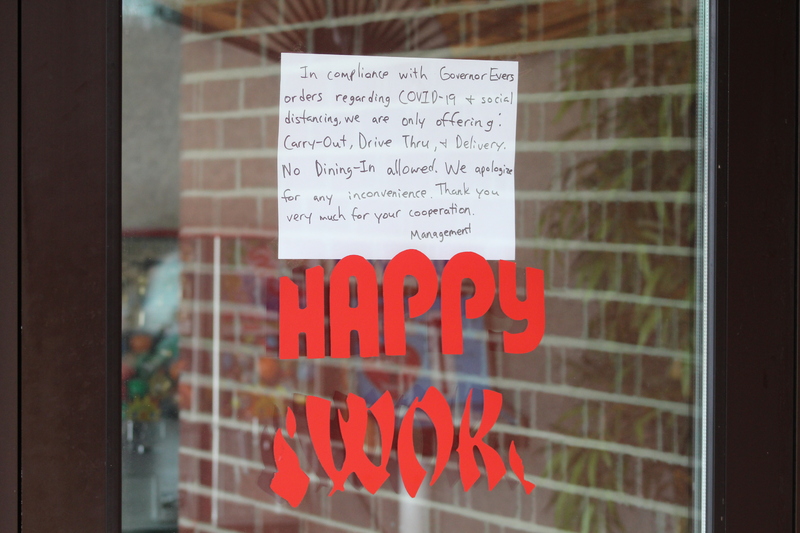 2020-03-13
2020-03-13Madison Orpheum Theater Covid sign
In March 2020 Wisconsin had a state-mandated two-week lockdown. So, I went out with a camera (with a zoom lens that wasn't needed) and took pictures of the closed signs on businesses and of how desolate Madison was. -
2020-05
Waiting to be Connected
I moved out of New York City for a month in the spring of 2020 during the period where my gallery furloughed most employees aside from the principal directors and a select number of sales people. I spent that time with my father in upstate New York in a close quarters quarantine. I was always struck by the quiet during the day and how visible and bright the stars were at night. Two things that seemed foreign to me at times as I grew up in cities and had lived in various Brooklyn neighborhoods for the past year. The passing sound of car stereos and people’s voices on fire escapes from a floor above were white noise. All vibrant - completely alive - no stars. His apartment was a studio and at the time he had not yet begun paying for internet service. Some nights we would drive four or so minutes down the road to the apartment complex where my Dad used to live a few years prior. We would camp outside the complex’s gym which housed one or two treadmills and the outside looked like a glorified garage - but it had wifi. As we were no longer residents and owners of a key pass to the facility, my Dad would pull up to the side entrance and put on his hazards. I would jump out and begin to search for a signal and attempt to connect to the complimentary internet. Whenever a stray person would emerge from their units to retrieve Amazon packages from their front stoop, I would make uncomfortable eye contact with them, as I held up my phone. Yes, yes, this is what you think it is. They hastened back up and quickly closed their door behind them. I found that the most expedient way of downloading content was to position myself by the exterior front left corner and stand with my back flush against the wall. Every night my Dad and I listened to podcasts and drank tea. Despite everything, moments like these helped us laugh and I look back at this memory fondly. -
 2021
2021Map of Camp Wolfeboro
This is a map of Camp Wolfeboro that was on the Golden Gate Area Council website during the summer of 2021. The map includes the various paths and trails, as well as the program areas, buildings, and campfires. -
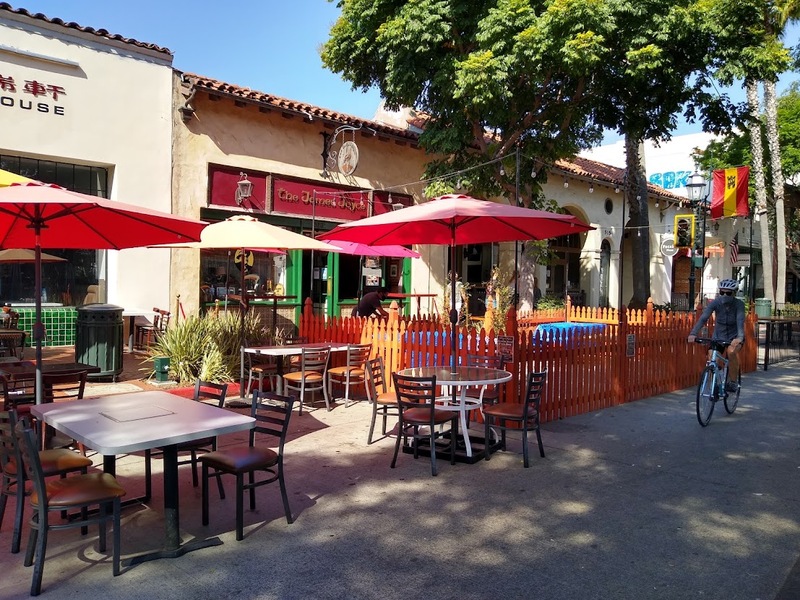 2021-07-30
2021-07-30Santa Monicans Rediscover the Joy of Walking and Biking and Reclaim their Streets
As an architect and planner with a strong interest in creating sustainable communities, I have worked for years on promoting safer and lively streets which encourage walking, bicycling, outdoor activity and social interaction. Too often our streets prioritize moving and parking cars over all other activity. One of the most positive aspects of the Covid pandemic was the number of residents I saw walking and bicycling with their families. The Ocean Avenue bike lanes now enable cyclists to enjoy the ocean view instead of fearing being crushed by a tourbus or foodtruck. Another exciting development is the expansion of outdoor restaurants into curbside parking, parking lots or even previous auto travel lanes. The result is a much more lively streetscape, a safe way to enjoy a restaurant meal, and a great way to enjoy our perfect climate. Let's continue this trend of reclaiming our streets for people to walk, bicycle, scoot, dine, shop and mingle, by reducing the space we sacrifice to moving and parking cars. -
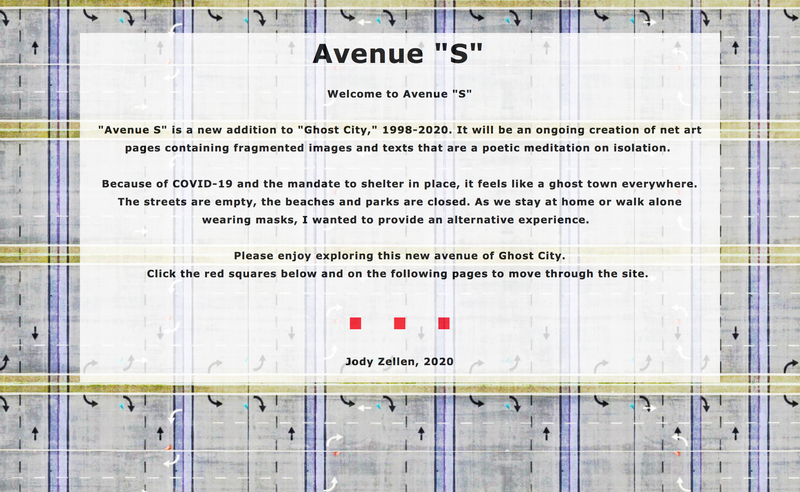 2020-03-31
2020-03-31Ghost City Avenue S
"Avenue S" a new addition to "Ghost City," 1998-2020. It is a ongoing creation of new web pages begin in March 2020 containing fragmented images and texts that are a poetic meditation on isolation. Because it felt like a ghost town everywhere at the beginning of the pandemic: the streets were empty; the beaches and parks were closed people stayed at home or walked alone wearing masks, I wanted to provide an alternative experience. Avenue S, in retrospect has become a visual journal of the year of Covid-19. -
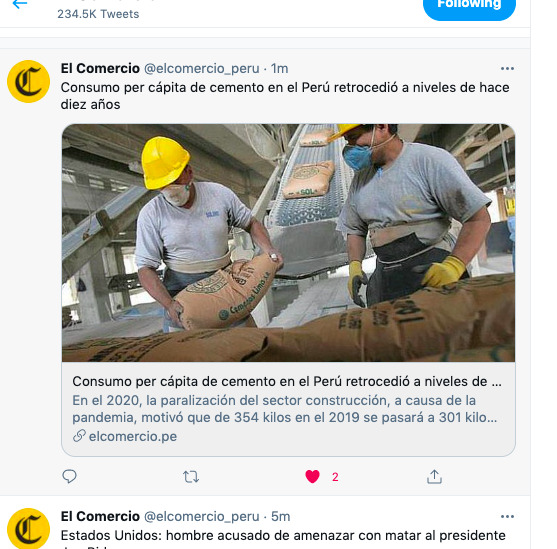 2021-03-16
2021-03-16Consumo per cápita de cemento en el Perú retrocedió a niveles de hace diez años
The cement industry has always been stable, expensive, and increasing. In urban areas, space is precious and construction is costly. This article is very telling of how the pandemic has affected the construction industry and cost of materials -
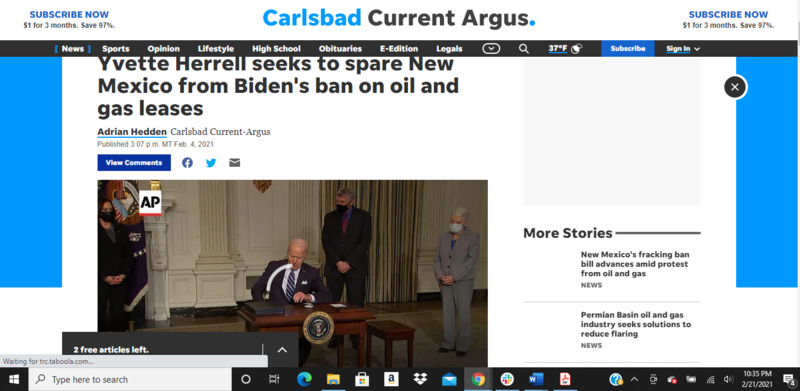 2021-02-04
2021-02-04US Rep. Yvette Harrell seeks to spare NM from Biden's ban on oil and gas leases
This article from Carlsbad Current Argus reporter Adrian Hedden explains NM District 2 Congressional Representative Harrell's efforts to preserve the oil-and-gas driven economy in New Mexico. The oil and gas lease referenced here applies to federal lands, and the ban of new lease issuance impacts existing operations. Much of southeastern New Mexico is federally owned, while nearby Texas is predominantly private land. The effect of this ban, if successful, would merely drive operations a few miles across the state line without largely impacting production from within the Permian Basin; it will, however, destroy the New Mexico economy, approximately 40% of which depends on oil and gas operations within the state. This article and topic are important to me because of my familial ties to New Mexico, but also because it demonstrates the unintended and myopic objectives set forth in this particular executive order. The economic impact of this ban would further exacerbate community and statewide problems related to COVID-19 as homeless has recently spiked in that region, and the disappearing tax base has further inhibited county and state programs and operations. -
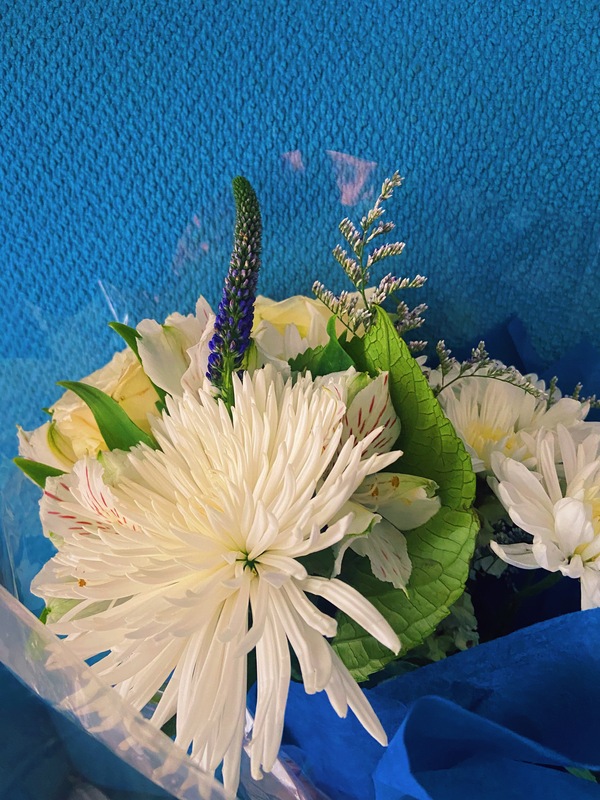 2020-12-14
2020-12-14Florist during the pandemic
John Mello runs a small local flower shop that has been providing flowers to the local community for years. When the pandemic hit, quarantine was a major adjustment for John’s business. Customers who regularly came in for celebratory gifts, flowers prom, and wedding flowers, no longer came in at their usual rate. As a result, John’s business slowed. This flower represents the fragile life of a local business, and how without the consistent type of attention it needs, like water and sunlight, it will die just as quickly as a flower. -
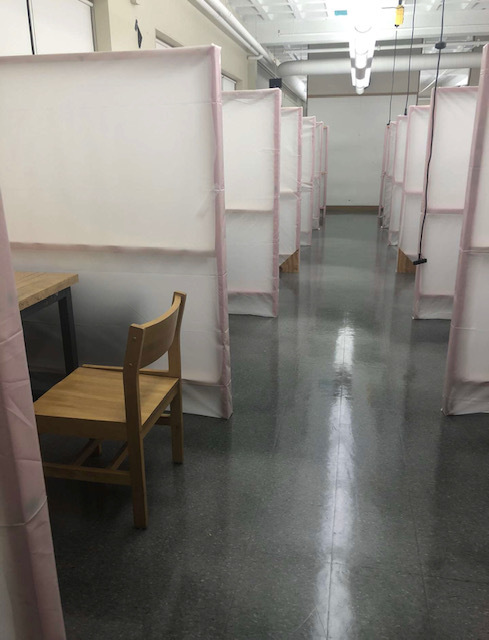 2020-11-04
2020-11-04Architecture Studio During a Pandemic
As college student studying architecture, it has been quite hard for me to adapt to this new reality of Covid-19. I would like to talk about is a picture that I received from a friend, of the current state of our studio space that we had last year. To put you in context, I have not been at school since December 2019, therefore I have not seen the measures put place by the school to allow students to use the architecture studio space. I was shocked and sad when I saw the picture because with all the preventions that the school put in place, I realized that the studio does not have the same feel and energy that it had before. I found it very sad because most of what made studio classes so fun was the fact that you could interact with people and talk about different projects and ideas. I can see most of this good energy is now gone and being at home is beginning to take its toll on everyone. This contact that we all cherished is now gone and it is getting harder to keep pushing forward. -
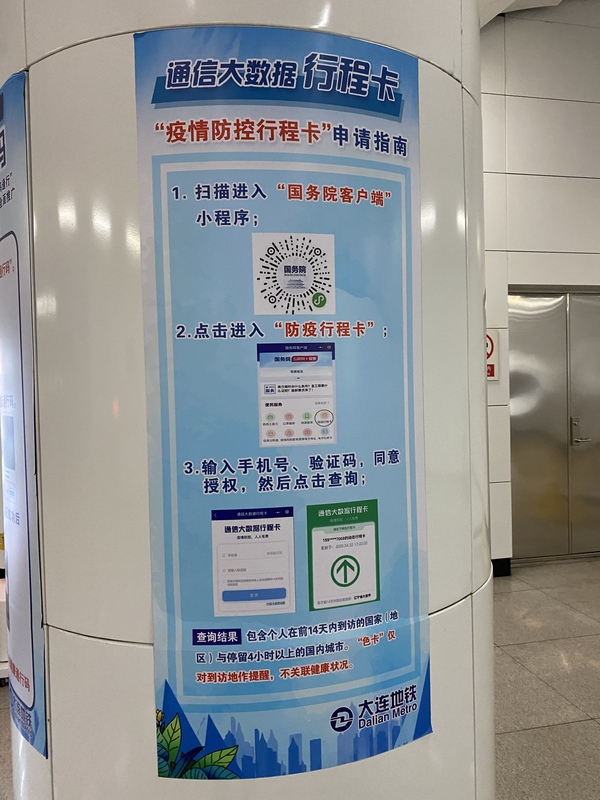 2020-12-04
2020-12-04How to retrieve your pass code
This is an instruction on how to retrieve your health code post in Dalian Metro. First, scan the code on the poster, then enter your phone number to retrieve the code. You could only enter the metro if your code is green. -
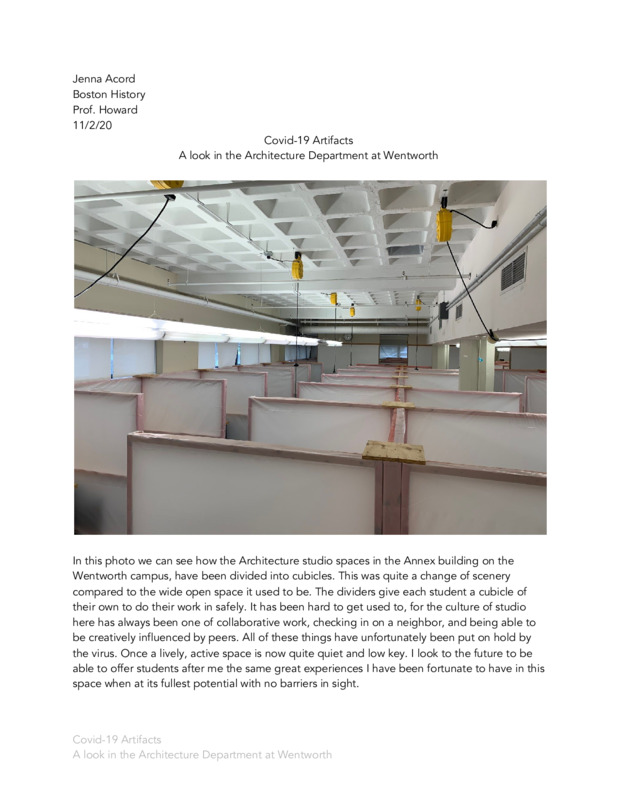 2020-12-03
2020-12-03Wentworth Facing Changes; The Architecture Studios
the Architecture studio spaces in the Annex building on the Wentworth campus, have been divided into cubicles. This was quite a change of scenery compared to the wide open space it used to be. The dividers give each student a cubicle of their own to do their work in safely. It has been hard to get used to, for the culture of studio here has always been one of collaborative work, checking in on a neighbor, and being able to be creatively influenced by peers. All of these things have unfortunately been put on hold by the virus. Once a lively, active space is now quite quiet and low key. I look to the future to be able to offer students after me the same great experiences I have been fortunate to have in this space when at its fullest potential with no barriers in sight. the use of all Covid protective measures being used in the CNC space over at the CfAR labs in the Wentworth Annex building on campus. PPE measures are very important to uphold in lab spaces where students have to collaborate with one another in order to successfully carry out their projects in the Architecture Department. These two students are seen wearing face masks, face shields as well as staying 6’ apart in order to maintain safety regulations. It is important to follow these regulations in order to continue our collaborative work flow. It took some time to get used to and has given the students new challenges to face while trying to safely share ideas and drawings with one another as well as working together in the lab spaces. From leaning over desks to draw on the same paper, to sharing tools, most aspects of collaborative work in architecture school have had to be rewritten in order to keep each other and professors safe during these times. -
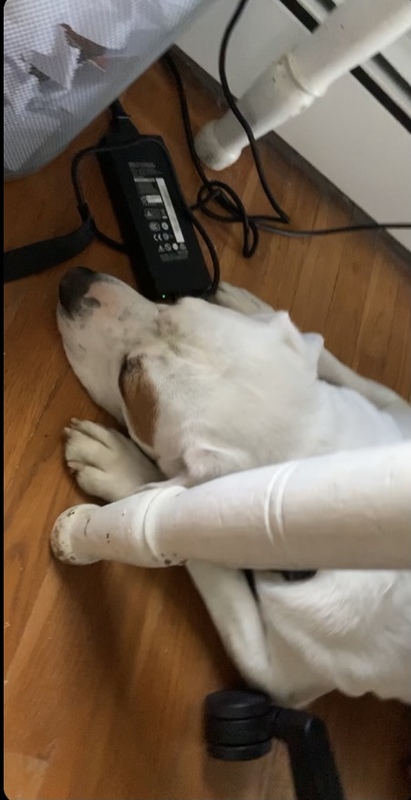 2020-11-30
2020-11-30Back-to-Back Fully Online Semesters
As soon as the Coronavirus hit, everyone was affected in either how they would work or how they were getting an education. I am currently an architecture student at Wentworth Institute of Technology in Boston, MA. I think everyone had hoped that the pandemic would be wrapped up in just a few months but unfortunately it was not. By summer 2020 I was about to begin my second semester of sophomore year with it being fully online. It was an extreme learning curve, classes were all on Zoom, and there was limited communication between me and my fellow classmates. We had to adapt from the handmade models we had done in previous years to digital models on new programs we had not used before. Through the entirety of the summer online semester, we had high hopes that somehow the fall semester would be different. But it was not. While the promise of hybrid classes was presented, everything was still so unknown that many of those promises fell through. We were told of the potential of a few in-person studio days and many students, like myself, decided to live on campus or even sign leases for apartments. But we were again met with the harsh reality of those in-person classes not happening. My school had come out with a plan of in-person studio days and we juniors were shocked to see that only our grade was given zero. We argued for at least a few in-person days throughout the semester, especially after having spent the entire summer semester fully online. We were finally given an opportunity to have an in-person class. While it is the reality that some of these events were out of the control of the school, it is still taking quite a toll on the students. We are losing that essential in-person connection that we usually get with classes such as studio. With the Covid-19 virus still ever present in November of 2020, we all have dim hopes of what the Spring semester of 2021 will bring. -
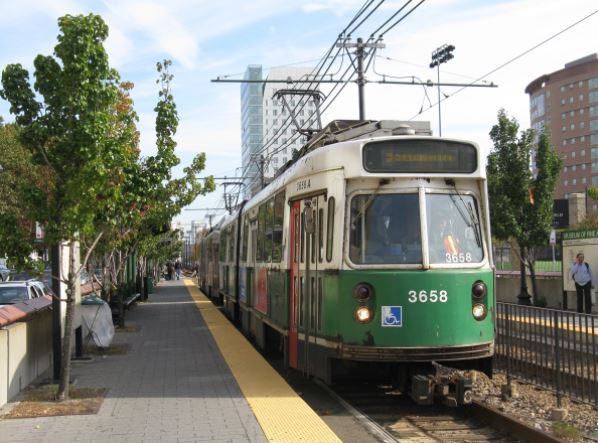 2020-12-01
2020-12-01Transportation Troubles
The decision to stay safe or risk quarantine has always been available to people, however with the small-scale reopening of schools among Boston's Colleges of the Fenway bordering the green line it is made more apparent. With the increase of people returning to some semblance of normal by using public transit, there has been discussion of an increase in prices for using such services due to the lack of financial stability. With this, there has been no massive shift yet, but there are noticeable increases being made that the public is wary of. Interestingly enough, this is restarting another conversation in the practicality of marketing public transportation. This in part references the lesson I was made aware of in my Boston History class, which talked of the backlash the greenline originally faced as it made its way into the unknown and potentially dangerous waters of underground transit. There was also discourse over charging for using such means of travel as it seemingly only affected the lower class that it served in majority as the middle to upper classes could travel independently. -
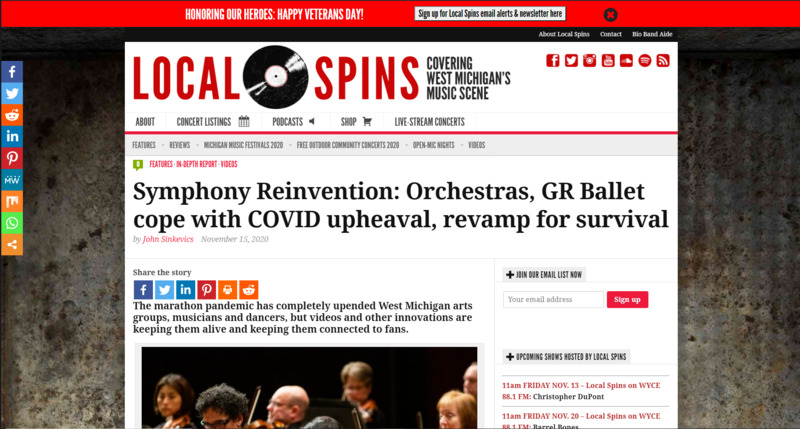 2020-11-15
2020-11-15Symphony Reinvention: Orchestras, GR Ballet cope with COVID upheaval, revamp for survival
With concert halls unable to open due to COVID-19, many performing arts groups have to find alternate ways to perform and raise money. -
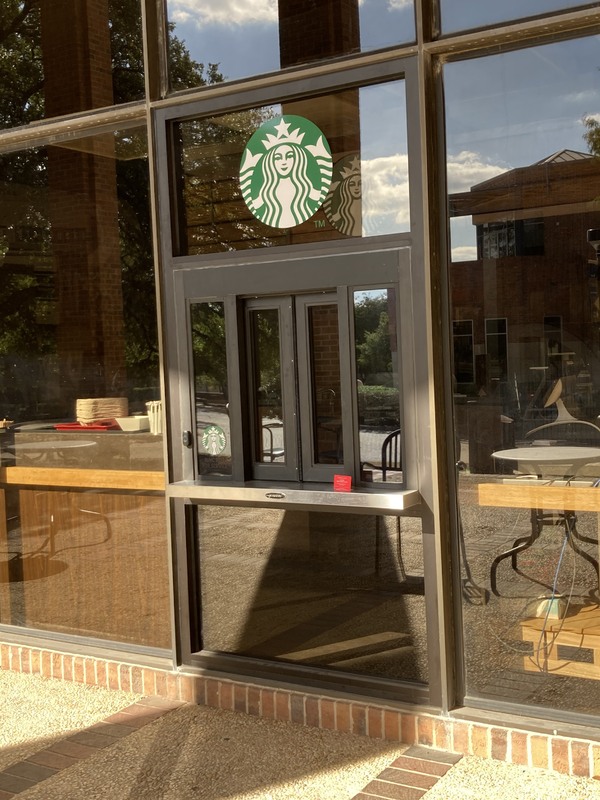 2020-11-16
2020-11-16Modification to Library
One of the busiest areas on campus is the Blume Library, particularly the Cotrell Learning Commons which is where the campus Starbucks is located. Changes were made to library operations in March and that included how the public would enter and exit the building. In order to limit the number of patrons inside the building, a walk-up window was added to accommodate those wanting to enter just to get Starbucks. -
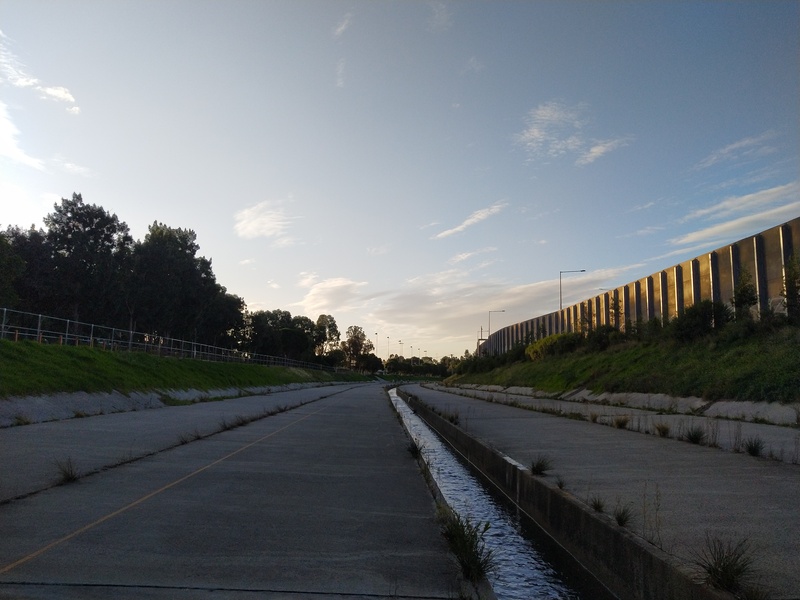 2020-07-05
2020-07-05The Life-Giving Locale
This is the Moonee Ponds Drain. Concrete behemouth. Primary function: transport storm water to the Bay via the Maribyrnong River. Secondary functions (that came to light under lockdown): bike path, rollerblading circuit, mushroom foraging field, freeway viewing platform, late night extension of the lounge room during household parties, study break spot, skate park, graffiti canvas, shortcut to nearby suburbs, and shopping cart disposal pit. This place truly brings the community together. HIST 30060 -
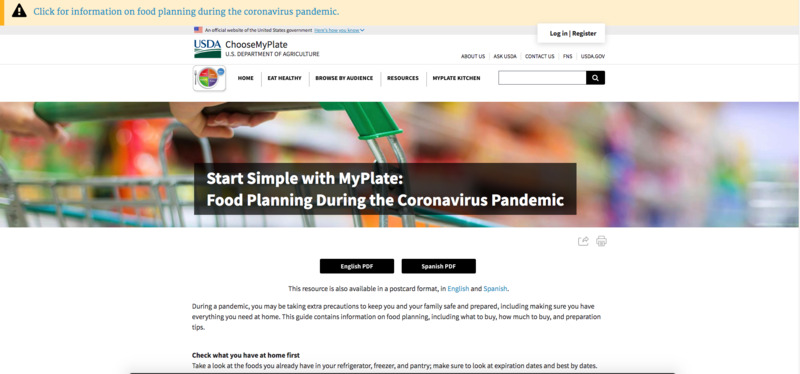 2020-03
2020-03Food Planning in a Pandemic
With many families not knowing quite what to do during the coronavirus, the government has laid out guidelines on how to safely plan during such a chaotic time. -
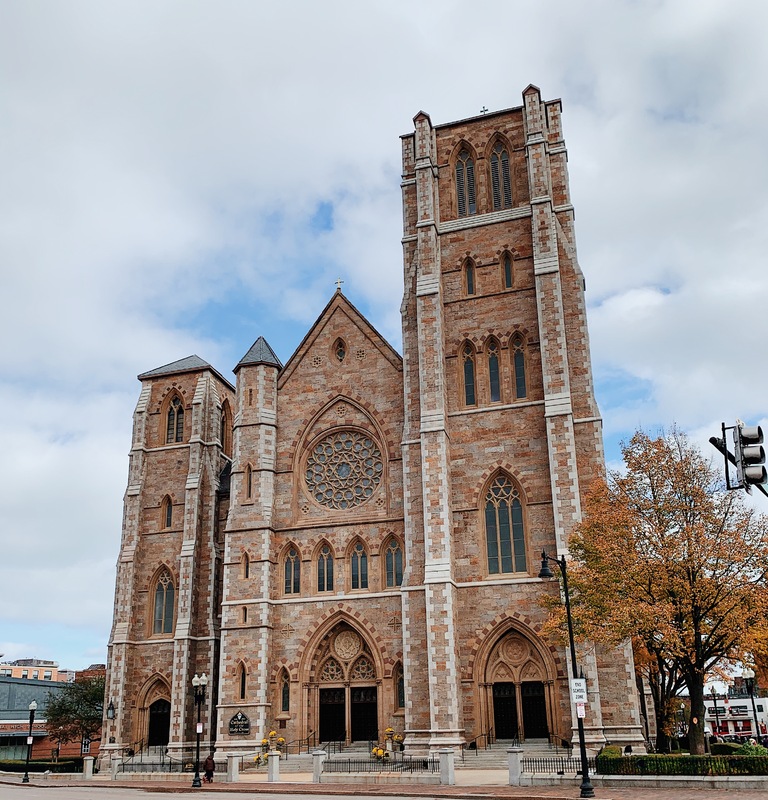 2020-11-02
2020-11-02South End Resilience
My name is Chandler Munson and I am a first-year student at Northeastern University in Boston, MA. Since I am apart of the NUin program, I am currently living in the Westin Hotel in Copley Square and am taking History of Boston as a culture class. Something that I've learned over the course of this semester is how to be resilient. The city of Boston has had to overcome so much with the current state of the Pandemic, yet people are still living their lives and bettering themselves. For my history class, I had to research the impact of Irish Immigration in Boston today, so I went with my group members to the South End. The South End was mostly inhabited by the Irish, so we went around finding historical sites and researching ways that the city has changed. One of the buildings that stood out to me was the Cathedral of the Holy Cross. The Cathedral is a place of worship and was especially important to the Irish Catholics when they first came to Boston. When I saw the Cathedral in person, I was taken aback. It is truly a beautiful building with perfect landscaping and many religious statues. At the beginning of the pandemic, the Cathedral had to shut its doors and hold online services. This upset many who think of religious places as their safe places and where they can truly be themselves. After many months of following the social distancing and mask guidelines, the Cathedral is finally open to the public. Of course, there is limited capacity due to COVID-19, but the community feels whole again. Visiting the South End really drove home the idea that America can overcome any challenge that it faces and that we will be back and better than ever soon. -
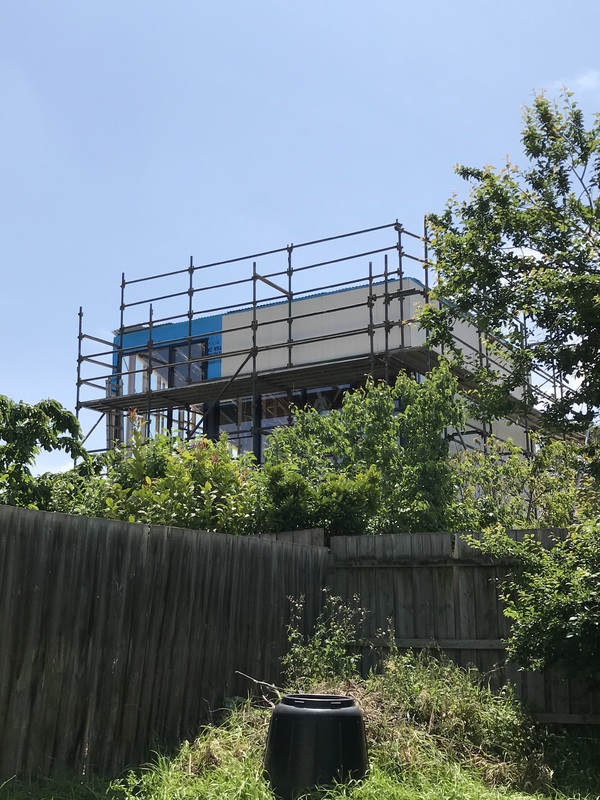 2020-08-29
2020-08-29Building of the house next door: progression
These are two images of the house being built on the block behind us. Due to us being home all of the time, we have been able to see the slow progress of the house being built. I was looking at this house being built so often, to the point where it wasn’t until two months later that I actually noticed just how much progress had been made. To me, these photos signify the daily repetition of our lives during the pandemic, especially during the lockdown periods. The picture showing the least amount of progress was taken on August 29, 2020 and the one showing more progress was taken on October 30, 2020. HIST30060 -
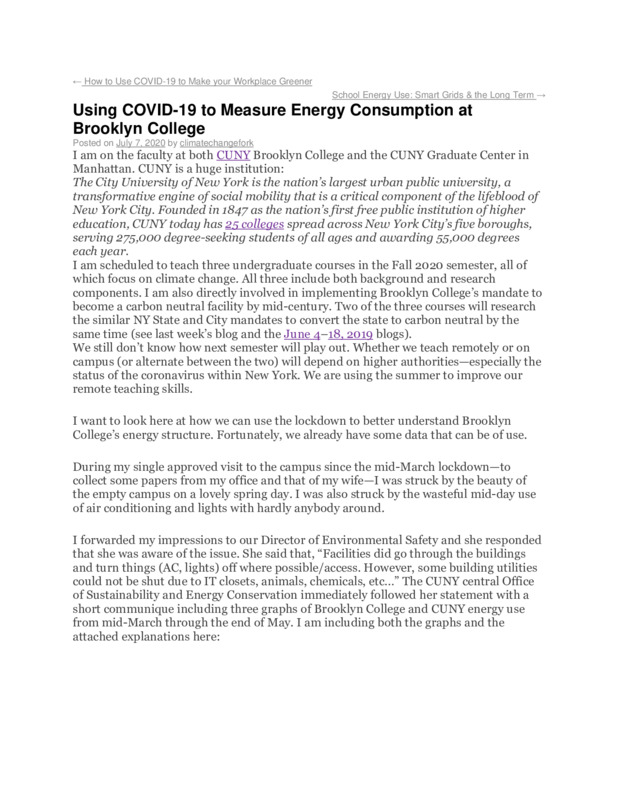 2020-07-07
2020-07-07Part of the blog that is used to teach on the impact of COVID-19 on energy use of Brooklyn College
This blog is used as part of the class that learn how to calculate the impacts of students on the energy use and carbon footprints of Brooklyn College. -
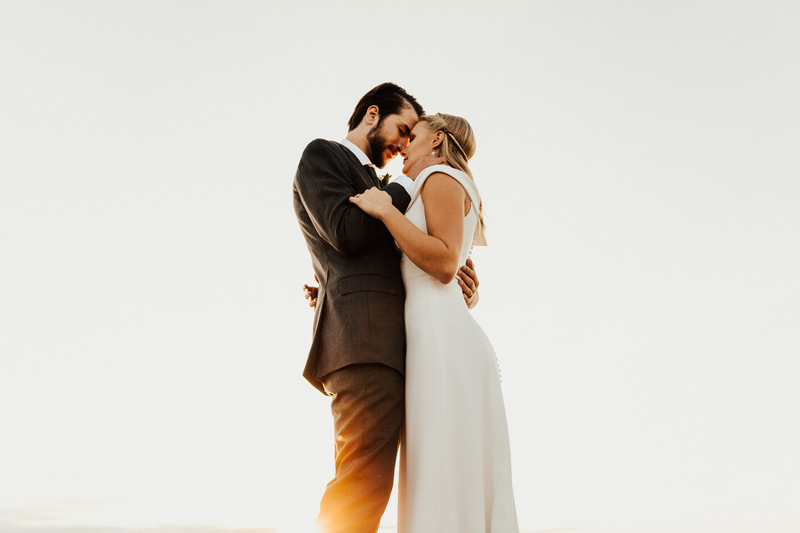 2020-10-14
2020-10-14Cancelled our Wedding Three Days Prior after receiving COVID-19 yet with an Unexpectedly Joyful Conclusion
It came as a surprise to both my fiance and I that we were infected with the COVID-19 Virus, also known as the “Corona Virus.” The shock did not originate in finding the virus itself, but the timing of the discovery itself. We were going to get married in three days. Before the news of Corona arrived, we decided to get ourselves married on her parents farm in the outdoors and have a grand celebration with all family and friends invited, about 200 people give or take a few. Her parents wanted to renovate the farm and turn it into a wedding venue for future events so building tables, benches, and acquiring all manner of silverware were necessary for the final product. When Corona extended its influence in the United States along with the first round of restrictions and small stores closing, we decided to decrease the size of the wedding by about 75, family and only very close friends only. We were glad we set the date to early fall as a spring or summer date would have been definitely cancelled; we believed Corona would have faded by then. After eight months of construction, carpentry, painting, and landscaping (a lot of landscaping), the slightly dilapidated farm turned into a small paradise surrounded by beautiful, wooded ridges on both sides. My fiance and I became well-rounded in all forms of renovation and wedding prep as we were first-timers in both arenas. It was perfect and everything we could have wanted. Corona was still continuing across the nation and a good portion of the invited decided to not come to the wedding, their replacement being lovely cards and well-wishes. This wedding was to be a big reprieve in the midst of the chaos. When the doctor brought back our results, I actually laughed out loud in the hospital room where my fiance and I were rapid-tested. For all the work, toil, and increasing disappointments we faced for the greater portion of the year, we would receive nothing, 2020 finally dealt us its trademark terrible hand. What happened next was quite a surprise. Rather than the expected emotional infection of defeatism and grief, our families breathed a sigh of relief. All the stress of the last few months finally disappeared. What was there to be stressed out about any more? The worst-case-scenario actually happened at the worst timing I have ever experienced… Yet, we were still here. Fortunately, only my fiance and I were infected; the rest of our families all tested negative. Even more fortune came our way as rather than cancelling the whole wedding, we were able to postpone to a later date a whole month later, October 2nd, 2020. We took the time to rest and relax, along with planning precautions we would have never seen if Corona never affected us directly. Today is October 14, 2020. My fiance now wife, Sophie, and I have been happily married for about a week and a half. We just placed the finishing touches on our new apartment and stocked our pantry and fridge with our first grocery run together. Our honeymoon to northern Minnesota was a resounding success. The weather couldn’t have been more beautiful and the colors more vibrant! I am just starting my senior year in college, hoping to complete a degree in History by next Spring and pursue my Masters soon afterwards. Sophie is currently working for her parents as her recent completion of a Piano Performance degree has yet to fulfill its purpose (The musical arts are currently smothered due to Corona), hopefully by spring a solution will present itself! I am so glad the discovery of this Archive came when it did. The story is so fresh in my mind and the Archive’s values in rapid-response collection and full inclusivity match perfectly with our current state. I hope this story is inspiring and empathetic to those who read as every story I have thus read on this Archive has made me feel stronger and more confident amidst a terrible storm. Thank you for reading! Ian Stewart -
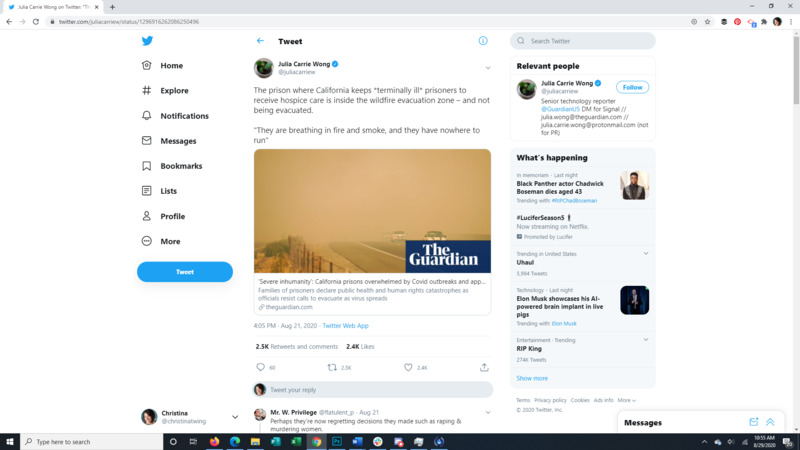 2020-08-21
2020-08-21'Severe inhumanity': California prisons overwhelmed by Covid outbreaks and approaching fires
This Tweet and article concern the conditions inmates in California's prisons are experiencing. First they had to deal with Covid-19 and figure out how to slow the spread of the disease within overcrowded facilities where social distancing is impossible and mask wearing presents its own set of issues. Second incarcerated people are living in a near constant state of lockdown, visitation and even communication with family and friends is gone. Third they are facing the threat of wildfires within a few miles of several prisons causing the people inside the buildings to breath air filled with smoke. To add insult to injury the state of California uses prison labor to fight these same fires. This article illustrates how we as a society treat those most at risk among us. Even those in a correctional facility for the terminally ill in hospice care are not being evacuated. -
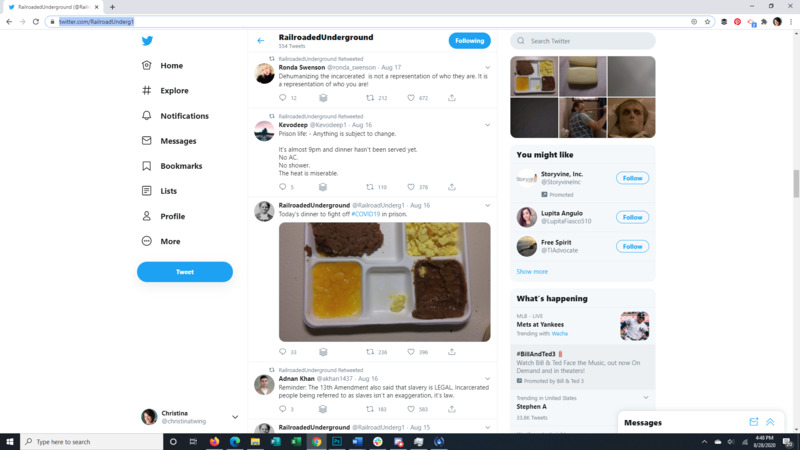 2020-08
2020-08Tweets from Inside a Prison 08/16-08/22/2020 by Railroaded Underground
These Tweets were posted by a man inside a prison using a contraband cell phone. This week he talks about their nutrition, lack of air conditioning, lack of showers, the wildfires near Vacaville Prison in California and the lack of plan for evacuation, a friend that recently died of Covid, and how good it felt to finely be allowed to go outside for a bit. -
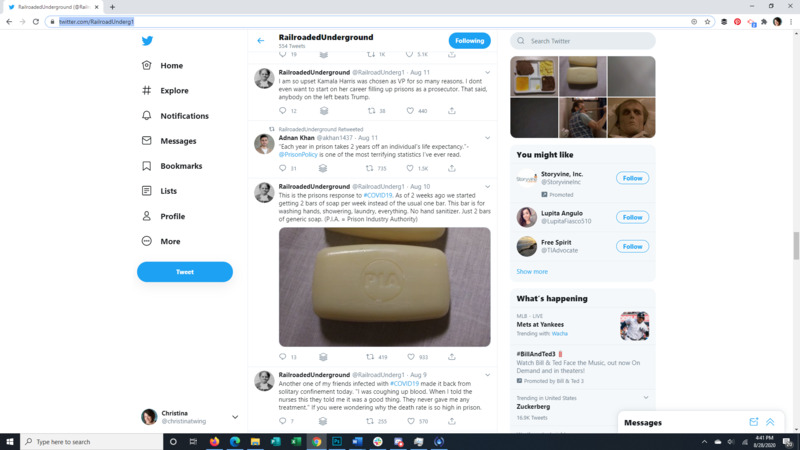 2020-08
2020-08Tweets from Inside a Prison 08/09-08/15/2020 by Railroaded Underground
These images show the Tweets of an incarcerated person using a contraband cell phone. This week he Tweets about politics, specifically Kamala Harris being chosen for VP and her role in incarcerating so many people while she was a prosecutor, another friend returning from solitary confinement, an unsanitary kitchen prison laborers were forced to prepare food in, the number of incarcerated crime victims, prison population reduction, getting more soap, and having to share a shower head with three or four other people because the prison removed several shower heads. -
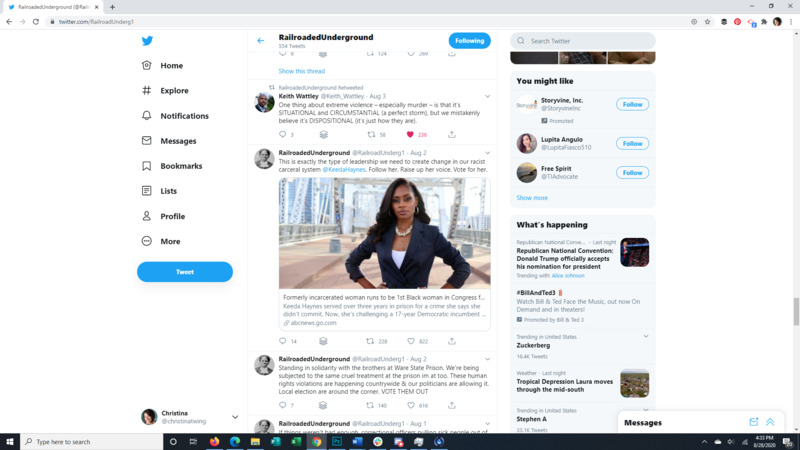 2020-08
2020-08Tweets from Inside a Prison 08/02-08/08/2020 by Railroaded Underground
The images show Tweets from a person incarcerated in a US prison using a contraband cell phone. These week he mentions politics, retweets several people including one person discussing who is worthy of release, people being sent to solitary confinement to quarantine, and the people at his facility being told they must cooperate with rehousing assignments or be punished. -
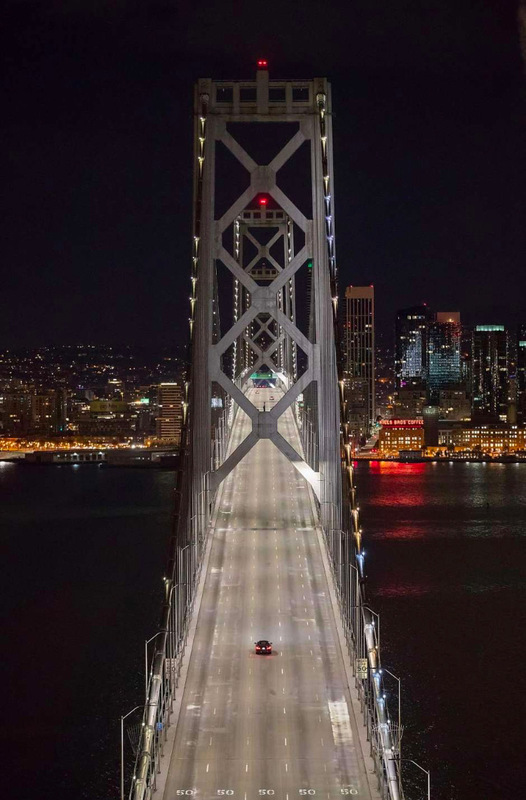 2020-03-18
2020-03-18An Empty Bridge
This is a picture of the Oakland Bridge in the Bay Area, California, while completely empty due to the initial Covid-19 lockdown. This bridge normally has thousands and thousands of people crossing it on any given day, and at any given moment it will typically be packed with commuters. In the photo, it's almost completely empty. This uncanny image was the first thing that made me, living in a city on the opposite side of the country, realize just how serious the virus would be. At this point in time, most of my friends and family still believed we would be going back to school within the month of March. It was unimaginable that we would still be dealing with the pandemic in August, when I am writing this, and that we probably will be dealing with this for the foreseeable future. The response to this pandemic was quite obviously botched by the US and its institutions that are supposed to protect us, and by the end of this hundreds of thousands of people will be dead as a result. I fear a lot of people in the future will blame this tragedy on everyday people's failure to lockdown, and I think this image serves as an essential reminder that when we were first told to lock down, the American people locked down. -
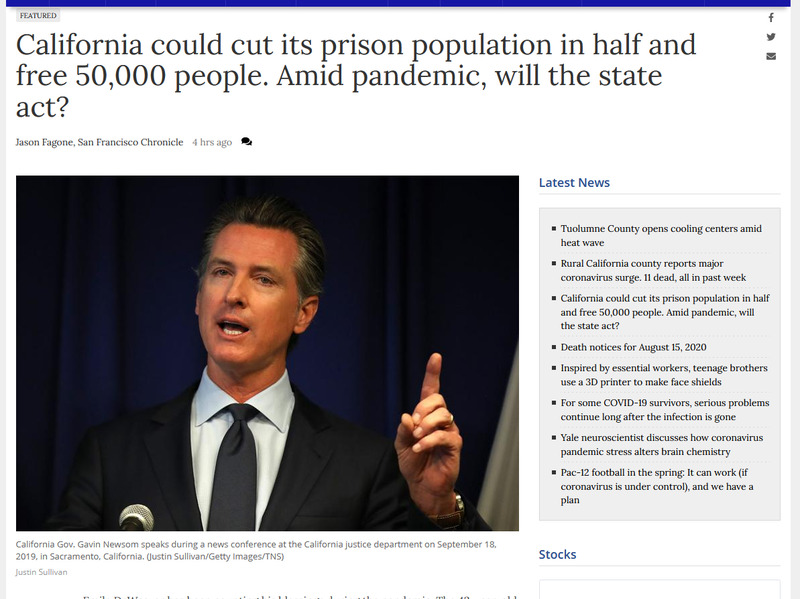 2020-08-14
2020-08-14California Could Cut Its Prison Population by 50,000 People
A news article discussing the potential release of thousands of prisoners to help relieve overcrowding during the COVID-19 pandemic. Large amounts of prisoners have been released in the past with no detriment to public safety. In a time when people are dying as a result of this overcrowding during a pandemic it would be incredibly beneficial to release these people. According to data, the issue seems to be one of political risk rather than of public safety. -
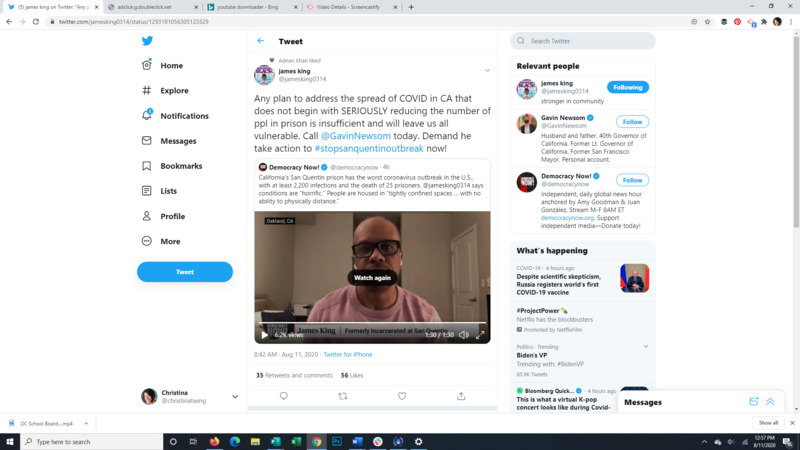 2020-08-11
2020-08-11We Have to Reduce the Number of People In Prisons to Slow the Spread of Covid
James King, formerly incarcerated and now a criminal justice activist, speaks out about the need to reduce the prison population to slow the spread of covid. He also explains the conditions at San Quentin Prison in California and in the replies to his Tweet explains and quotes the recidivism rates for prisoners. -
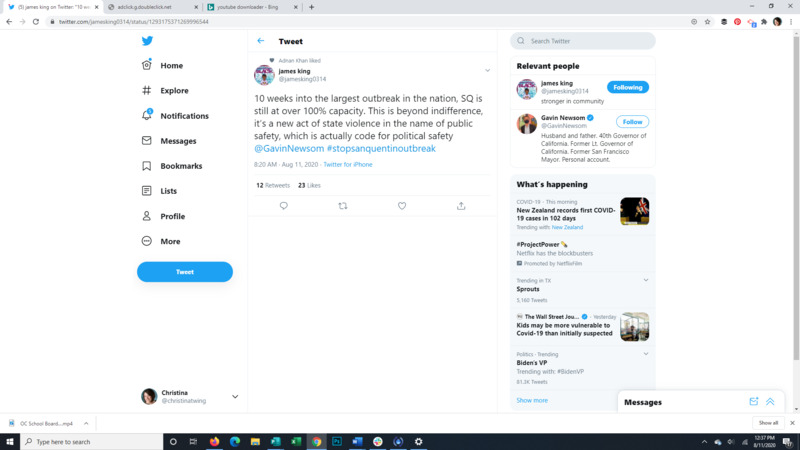 2020-08-11
2020-08-11San Quentin Still at 100% Capacity
Covid-19 has been eye opening and really illustrated many of the problems we as a society have done a good job ignoring. One of the things society has long ignored is overcrowding in prisons and jails in the US. We've also learned that any enclosed population without the ability to social distance is a risk for having a major Covid-19 outbreak. Together, overcrowding and the inability to social distance, has made for a bleak outlook in the nation's correctional facilities. This Tweet shows that even this far in to the pandemic and the outbreak at San Quentin the prison is still over capacity. -
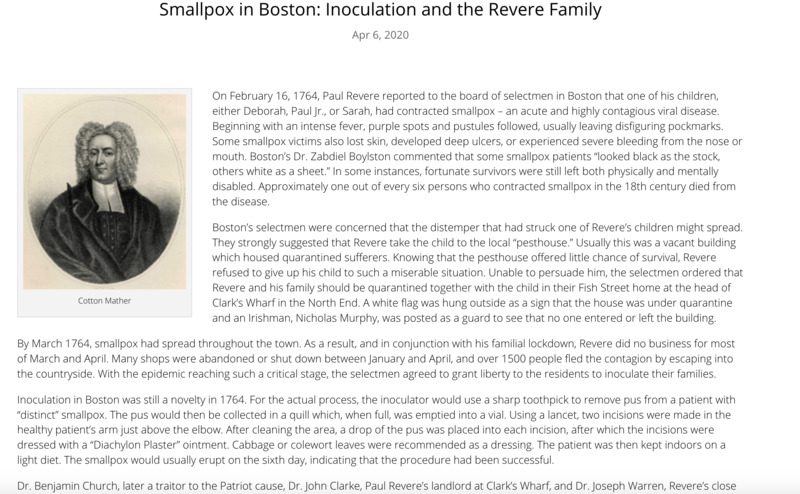 2020-04-06
2020-04-06Smallpox in Boston: Inoculation and the Revere Family
As the Covid-19 pandemic began to spread in Boston, museum interpreters at the Paul Revere house looked to the archives to learn more about how Boston has responded to wide-spread illness in the past. This blog post from The Revere Express blog explains how the smallpox epidemic effected the Revere Family and ways that 18th century medicine responded to the illness. -
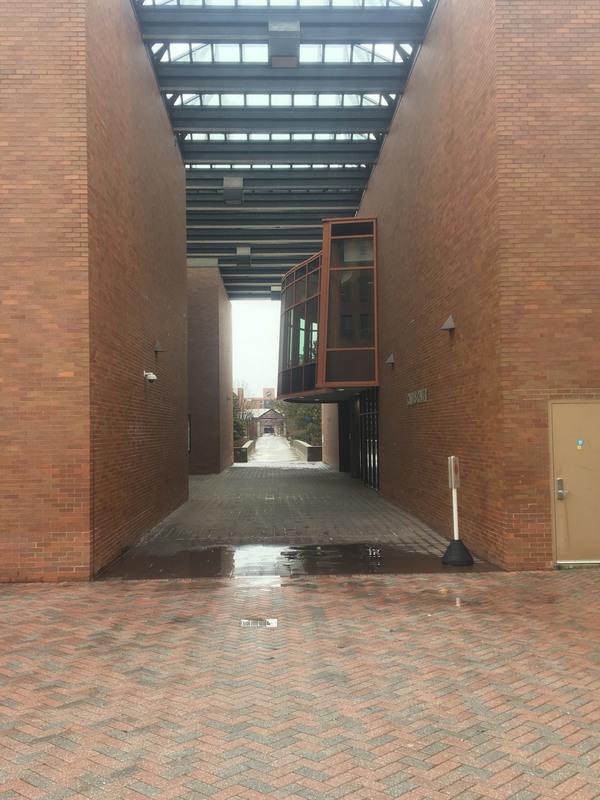 March 23, 2020
March 23, 2020RIT during a COVID-19’s Monday
At the beginning of close down in RIT, I was taking a walk around the campus to see if there is any place open. It feels extremely weird to see such an empty walkway during Monday with only a few international students, where normally there will be hundreds of students walking through to get to their classes or other building at this time. Plus, it was rainy that day, which made the whole scene feel more sad. -
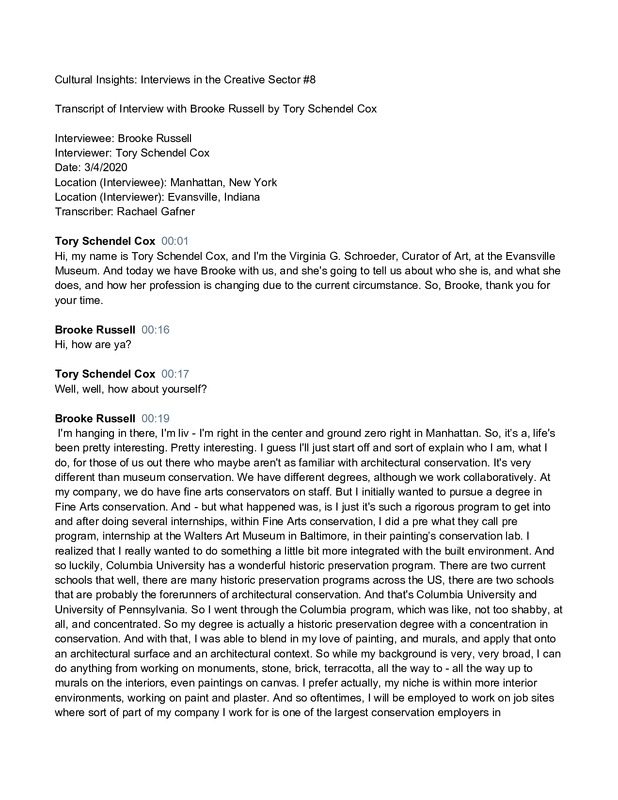 2020-03-26
2020-03-26Cultural Insights: Interviews in the Creative Sector #8… Brooke Russell, Evergreene Architectural Arts
In response to COVID-19, the Evansville Museum of Arts, History and Science launched the mini-series, "Cultural Insights: Interviews in the Creative Sector," to highlight colleagues and professionals working in the same or similar field of museum professionals. -
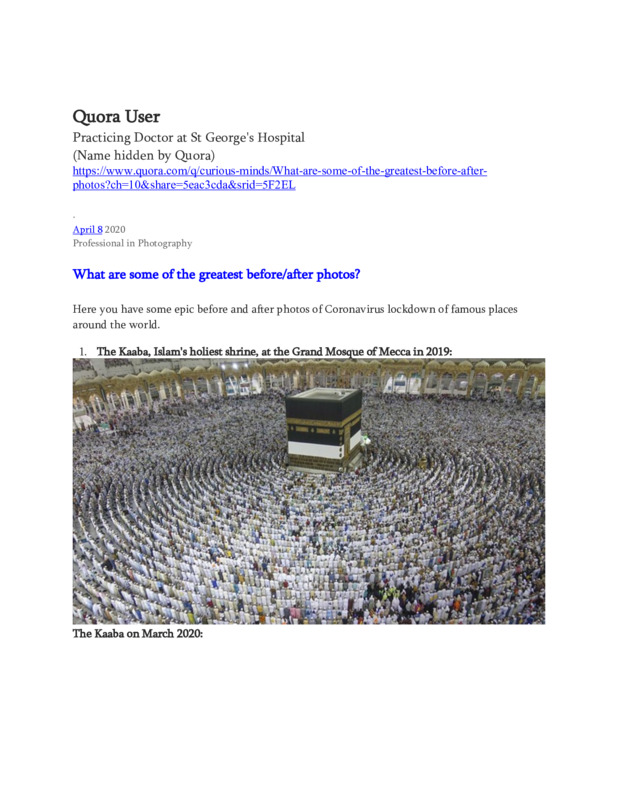 2020-04-08
2020-04-08Famous Landmarks Now Empty Due to COVID
Quora is a large forum for Asked to Answer (A2A) interchange. One user can post a question, and any other user or users can answer. In this case, a user posted photos of famous places that are now deserted because of COVID-19. The world is quite different now--hopefully only temporarily -
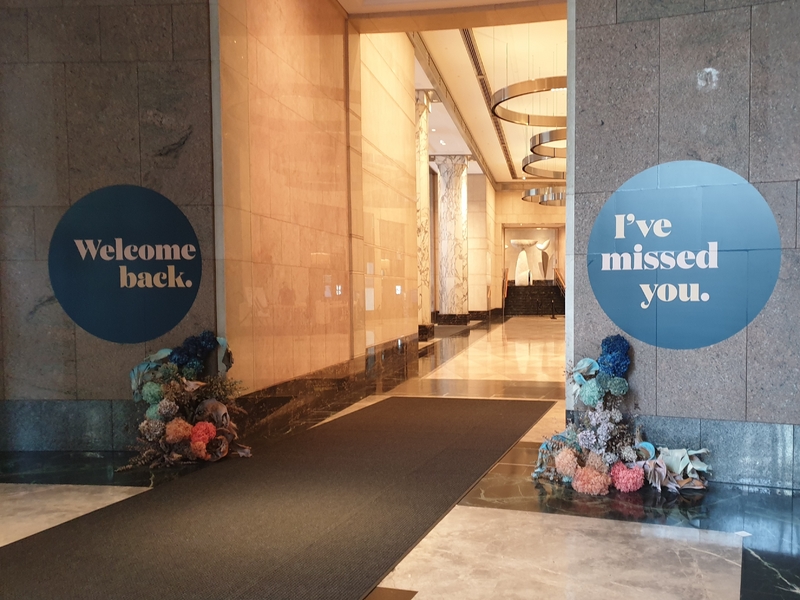 2020-07-16
2020-07-16Signs welcoming workers back to Chifley Tower, an office building in the centre of Sydney, New South Wales, Australia.
This photograph indicates measures taken to celebrate the easing of pandemic-related restrictions on the gathering of people in commercial settings. -
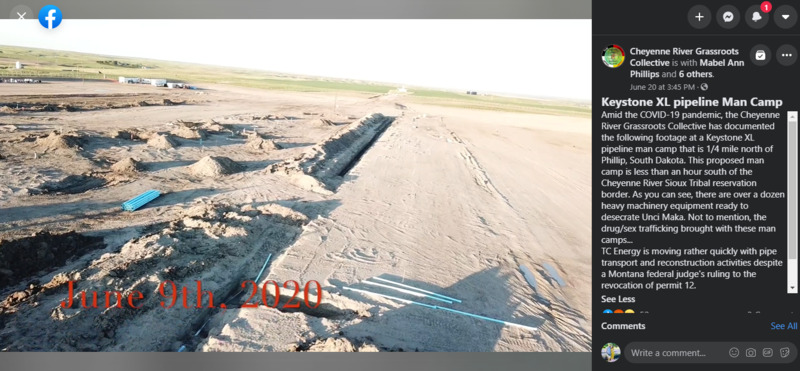 2020-06-06
2020-06-06Documentation of Pipeline Progress Amid Covid-19
From the Cheyenne River Grassroots Collective: Amid the COVID-19 pandemic, the Cheyenne River Grassroots Collective has documented the following footage at a Keystone XL pipeline man camp that is 1/4 mile north of Phillip, South Dakota. This proposed man camp is less than an hour south of the Cheyenne River Sioux Tribal reservation border. As you can see, there are over a dozen heavy machinery equipment ready to desecrate Unci Maka. Not to mention, the drug/sex trafficking brought with these man camps... TC Energy is moving rather quickly with pipe transport and reconstruction activities despite a Montana federal judge's ruling to the revocation of permit 12. -
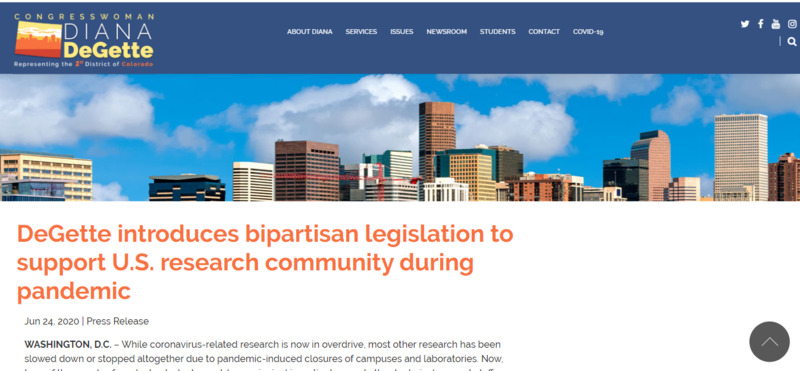 2020-06-24
2020-06-24Congresswoman DeGette Press Release, Funding for Covid research, bipartisan
Excerpt from press release: WASHINGTON, D.C. – While coronavirus-related research is now in overdrive, most other research has been slowed down or stopped altogether due to pandemic-induced closures of campuses and laboratories. Now, tens of thousands of graduate students, postdocs, principal investigators and other technical support staff are at risk of losing their employment and their work without federal relief. Additionally, with this research stopped, America may lose the benefits that come with new technologies and scientific insights. -
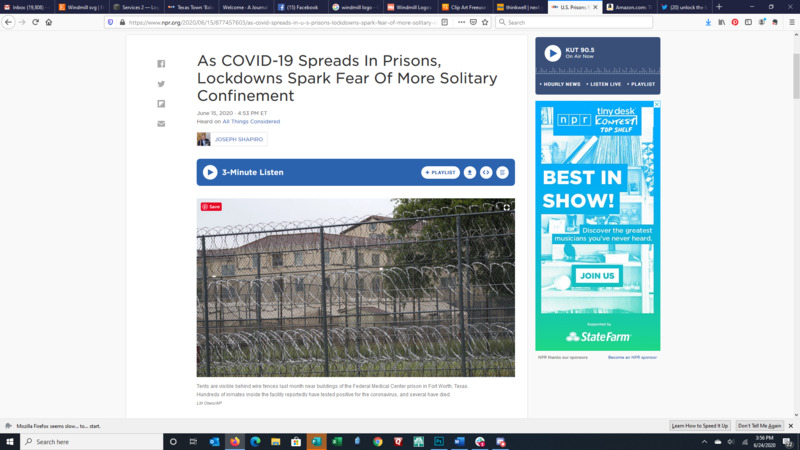 2020-06-15
2020-06-15As COVID-19 Spreads In Prisons, Lockdowns Spark Fear Of More Solitary Confinement
As the US struggles to deal with covid-19 so do the nations corrections facilities. Due to their architecture and systems the facilities are at high risk of covid spreading rapidly through their populations. Advocates are becoming increasingly concerned over a new policy in some facilities which are using solitary confinement as an answer to the problem of quarantine. While advocates of abolishing solitary confinement are concerned for all of the regular reasons this causes extra alarm because they are worried the practice will become more wide spread and more commonly used both during the pandemic and once it is over. -
 2020-04-30
2020-04-30Pandemic Pool Skating
If you believe Stacy Peralta‘s documentary Dogtown and Z-Boys, and of course you should — he’s one of the Lords of Dogtown for heaven’s sake, then you’ll know that pool skating originated here in Los Angeles during California’s drought in the late 70s. Some forty-odd years later and we’re in a drought of our own, a drought of socializing, of congregating, as humans across the southland and the world shelter at home to protect ourselves and the weakest among us from the novel coronavirus. But the empty pools and skateparks across Los Angeles, built for beginners, Olympic hopefuls and every skater in between, are being filled with sand and mulch so they don’t become deep, glossy-tiled petri dishes birthing a new surge of Covid-19 cases. There’s one problem. Just as no one could keep skateboarders out of backyard pools in the 70s long enough to keep a new sport from blossoming in a literal desert, a few tons of mulch or sand won’t help to board up skaters. That’s because essential services are still available. Big-box home improvement stores are open for business, stocked with antidotes to debris: shovels and shop vacs, push brooms and blowers. But of course we pool-riders are already equipped with such technology. So go ahead and fill that pool with mulch, dump and spread sand across the street courses. Skaters will eventually show up at odd hours to push and blow it out of the way. We’ll don our personal protective equipment, helmets, wrist guards, knee and elbow pads, and get in a quick session before you ever notice. We don’t even need to clear out the whole pool. A half, or even a quarter pool will do — like the quarter pipes we would hammer and scrap together at the bottom of our driveways in the 70s and 80s. We’d risk life and limb skating to the top of those rickety booby-traps pushing our wheels over the edge like we’d see Stacy and Tony Alva do in magazines (those things we’d use if we ran out of toilet paper). Skateboarders are creative, resilient, unrelenting. Ian McKaye of Minor Threat calls skateboarding “a way of learning how to redefine the world around you.” We see the world differently. Where you see an empty swimming pool, skateboarders see the form and shape and flow of concrete waves to ride. Where you see a curb and sidewalk, skateboarders see an edge to grind, a platform to manual, or wheelie, across. Where you see an empty corporate plaza, skateboarders see a playground of infinite lines to skate, slide and grind across. Where you see pools safely filled with sand, we see an opportunity to perform a ritual baked into our DNA, a ritual of clearing and cleansing. And in the emptiness we’ll skate new lines, try new tricks, push to new heights. As Craig Stecyk understood, according to Skip Englbom in Dogtown and Z-Boys, children took the ruins of the 20th century and made art out of it. And in the ruins of this pandemic there will only be more art. A lot of pool skaters aren’t children anymore. We’re the old guard, Generation X skaters with kids to care for at home, and parents to shop for so they don’t have to risk a Costco run. So we will keep a couple arms’-length apart as we sweep and skate, clear and carve. Because we can’t help ourselves. Our godfathers showed us how. Lance Mountain explains, “skateboarding doesn’t make you a skateboarder. Not being able to stop skateboarding makes you a skateboarder.” A crisis created skateboarding as we know it. No pandemic or sand-filled dump truck is about to stop its progress. -
 2020-06-10
2020-06-10Petition to Change a Park's Name During the Pandemic
Even though the pandemic still lingers, the world is pressing on to combat other issues. The recent protests have reawoken the subject of racism in America. I believe the pandemic has afforded us with a unique situation where the nation has more time to discuss this issue at large. Plus, a lot more people have participated in those protests because they are either working from home or have lost their jobs, unfortunately. With all this additional time, people have sought to make changes to promote a more welcoming environment for the black community in many towns and cities. Thousands of residents in Wilmington, NC, have already begun a petition to make such a change. One of the city's most popular parks was named after Hugh MacRae. This man co-lead the plan to overthrow Wilmington's local government. While doing this, his group also demolished a black-owned newspaper office and killed/injured many African Americans. This event became notoriously known as the 1898 Wilmington Massacre. Over 8,000 people have already signed a petition to change the park's name. An interview by WECT News I watched today really struck me. The woman, who was a peaceful protester, had been asked why she thought changing the name of the park was necessary. She told the news anchor that "'I grew up there, I had birthday parties there, and it was always a terrible reminder of the history of Wilmington and having that park, a public park be named after somebody of such vile reputation is shocking and it’s a shame that although Wilmington acknowledged its history it does not do more and be more proactive to make a change.'" The legacy that this man and his mob caused has continued to negatively affect the black community in Wilmington. Renaming that park could lead to a reconciliation of the past in the present day. The reintroduction of the issue of racism and Black Lives Matter might not have been as impactful as it was if the pandemic had not occurred in the first place. Having people at home watching TV (especially the news), helped garnered the attention it needed to begin the movement again. -
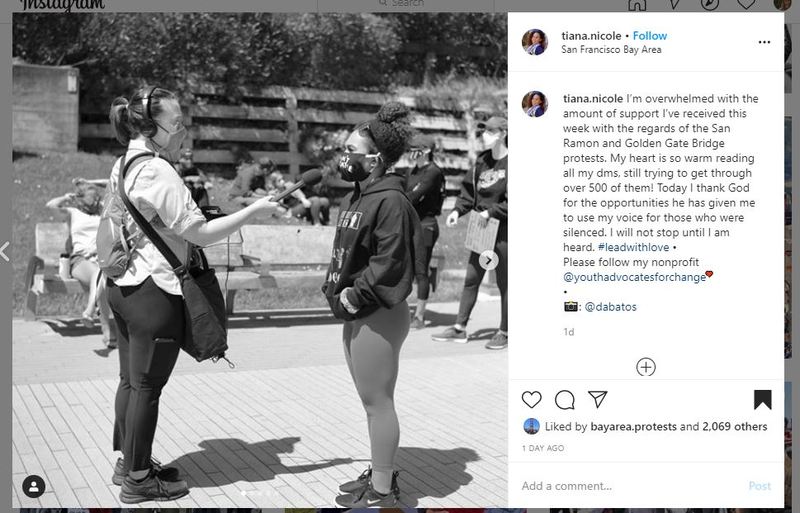 2020-06-06
2020-06-06Teens Organize Golden Gate Bridge Protests
The Golden Gate Bridge protest, that occured on June 6, 2020, was entirely organized and lead by two local East Bay youths. Tiana Day and Mimi Zoilia secured the permits that led to the first ever Black Lives Matter protest on the iconic San Francisco landmark. The outpouring of support for the pair has been strong. They have inspired youth across the San Francisco Bay Area to speak out for justice. Tiana's speech reveals the realities of growing up Black in what many consider to be an incredibly liberal region of the United States. -
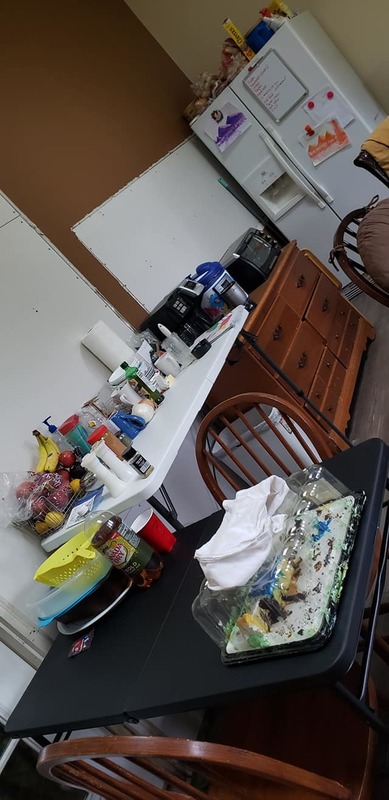 2020-04-14
2020-04-14We Were Remodelling Our Kitchen When Covid-19 Hit
My family was in the middle of remodelling our kitchen when Covid-19 hit the US. Because of restrictions on construction during the first few weeks, the construction was walled off and we had to move our fridge and some appliances into the living room. This is a photograph of the "kitchen" set up that we used for three months while the construction on our house was halted. We've lived through hurricanes, tornadoes, and other natural disasters that have impacted our access to food but none of them have been as difficult as living for three months without a kitchen. -
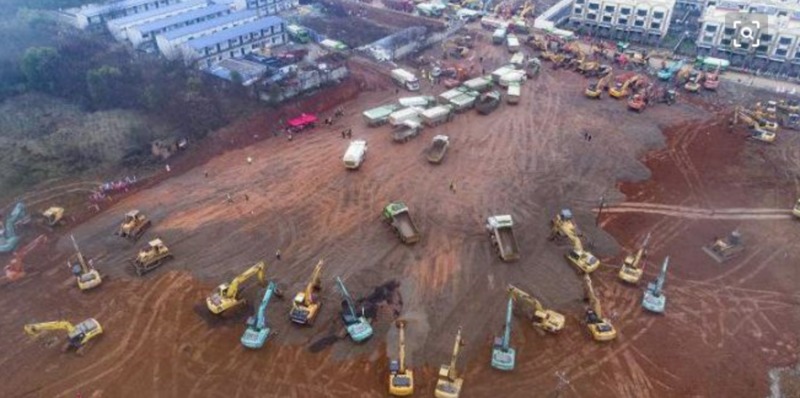 2020-02-04
2020-02-04China building up a new hospital within 7 days
Everyone is working hard to build up a new hospital -
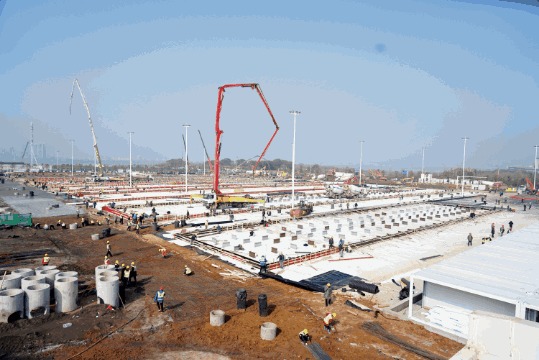 2020-01-24
2020-01-24A Miracle Built in Ten Days
These photos show that at the very beginning of the outbreak of the Covid-19 in Wuhan, China, the Chinese government decided to build a simple shelter hospital in ten days to treat these patients. The picture shows the construction site on the first day and close to completion at the end Scene. Ten days to complete this project is undoubtedly a miracle of anti-epidemic
